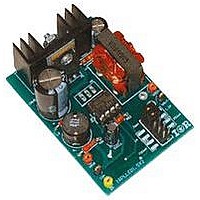IRPLLED1 International Rectifier, IRPLLED1 Datasheet - Page 13

IRPLLED1
Manufacturer Part Number
IRPLLED1
Description
BOARD EVALUATION FOR IRS2540PBF
Manufacturer
International Rectifier
Specifications of IRPLLED1
Current - Output / Channel
1.5A
Outputs And Type
1, Non-Isolated
Voltage - Output
24V
Features
Dimmable
Voltage - Input
50 ~ 170V
Utilized Ic / Part
IRS2540PBF
Core Chip
IRS2540, IRS2541, IRS25401
Topology
Buck (Step Down)
No. Of Outputs
1
Output Current
1.5A
Output Voltage
500mV
Dimming Control Type
PWM
Development Tool Type
Hardware - Eval/Demo Board
Lead Free Status / RoHS Status
Contains lead / RoHS compliant by exemption
If a MOSFET is used for the lower switch, reverse recovery losses are incurred during the dead time after the low
side MOSFET has been on and conducting current. During this dead time the low side MOSFET is off, but the body
diode is freewheeling and providing current to the load. Since the body diode is conducting current, carriers are
present and will eventually need to be recombined leading to reverse recovery delay. When the high side MOSFET
turns on the VS node is very rapidly pulled from COM to VBUS and the low side MOSFET or the freewheeling
diode conducts current from VS to ground due to the reverse recovery effect resulting in power losses. This can
result in overheating of the low side switching component and component stress, as can be seen in Fig. 17 to 18.
Since the power diode has a much shorter reverse recovery time the diode will conduct current for a significantly
shorter period and exhibit lower power losses. At lower frequency and reduced load current, the long recovery time
associated with the MOSFET body diode may not be an issue. For higher frequency higher current applications a
diode could provide lower power losses with respect to a MOSFET.
With a low side MOSFET fitted to the IRPLLED1 evaluation board reverse recovery current peaks 8A were
measured. This resulted in a temperature rise which could be reduced by replacing the low side MOSFET with an
appropriate freewheeling diode. The reverse recovery current peaks were reduced to 4.5A. The frequency was also
selected to keep the diode reverse recovery associated power losses low.
With the inclusion of a freewheeling diode instead of a low side MOSFET comes the need for an alternative means
of pre-charging the bootstrap capacitor CBOOT at startup. RS3 and RS4 provide a current path from the DC bus to
VB and from the output to COM in order to accomplish this. After the IRS2540/1/01/11 begins to switch and the
high side Buck MOSFET switches off after the first cycle, the voltage at VS transitions to 0V/COM due to the
freewheeling action of the lower diode. this allows CBOOT to charge through DBOOT in the normal way and this
operation is repeated every cycle. RS4 represents only a small power loss if the output voltage is below 30V,
however for higher output voltages a low side MOSFET is necessary.
Fig. 17 Using a low side FET, Vin = 100V, Iout = 1.5A, Vout = 17V
RD-0608
13
www.irf.com











